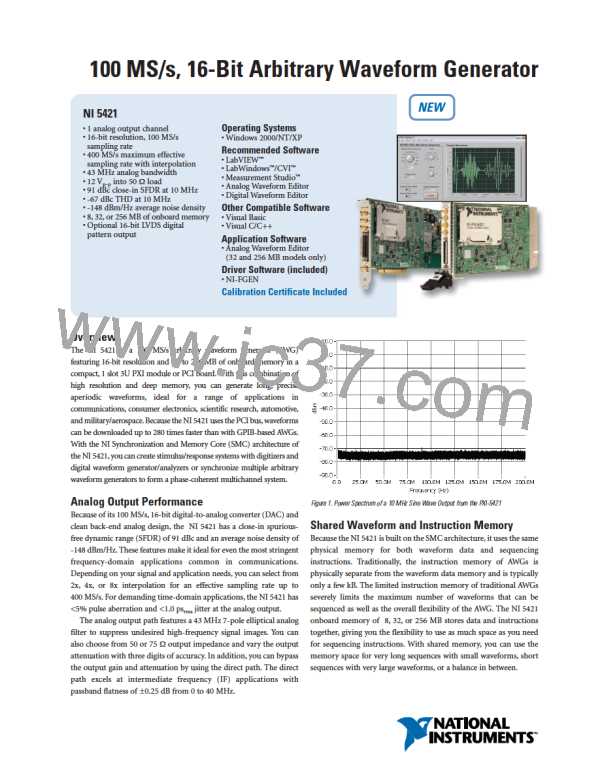100 MS/s, 16-Bit Arbitrary Waveform Generator
NEW
NI 5421
• 1 analog output channel
• 16-bit resolution, 100 MS/s
sampling rate
• 400 MS/s maximum effective
sampling rate with interpolation
• 43 MHz analog bandwidth
• 12 Vp-p into 50 Ω load
• 91 dBc close-in SFDR at 10 MHz
• -67 dBc THD at 10 MHz
• -148 dBm/Hz average noise density
• 8, 32, or 256 MB of onboard memory
• Optional 16-bit LVDS digital
pattern output
Operating Systems
• Windows 2000/NT/XP
Recommended Software
• LabVIEW™
• LabWindows™/CVI™
• Measurement Studio™
• Analog Waveform Editor
• Digital Waveform Editor
Other Compatible Software
• Visual Basic
• Visual C/C++
Application Software
• Analog Waveform Editor
(32 and 256 MB models only)
Driver Software (included)
• NI-FGEN
Calibration Certificate Included
Overview
The NI 5421 is a 100 MS/s arbitrary waveform generator (AWG)
featuring 16-bit resolution and up to 256 MB of onboard memory in a
compact, 1 slot 3U PXI module or PCI board. With this combination of
high resolution and deep memory, you can generate long, precise
aperiodic waveforms, ideal for
a range of applications in
communications, consumer electronics, scientific research, automotive,
and military/aerospace. Because the NI 5421 uses the PCI bus, waveforms
can be downloaded up to 280 times faster than with GPIB-based AWGs.
With the NI Synchronization and Memory Core (SMC) architecture of
the NI 5421, you can create stimulus/response systems with digitizers and
digital waveform generator/analyzers or synchronize multiple arbitrary
waveform generators to form a phase-coherent multichannel system.
Analog Output Performance
Because of its 100 MS/s, 16-bit digital-to-analog converter (DAC) and
Figure 1. Power Spectrum of a 10 MHz Sine Wave Output from the PXI-5421
clean back-end analog design, the NI 5421 has a close-in spurious- Shared Waveform and Instruction Memory
free dynamic range (SFDR) of 91 dBc and an average noise density of Because the NI 5421 is built on the SMC architecture, it uses the same
-148 dBm/Hz. These features make it ideal for even the most stringent physical memory for both waveform data and sequencing
frequency-domain applications common in communications. instructions. Traditionally, the instruction memory of AWGs is
Depending on your signal and application needs, you can select from physically separate from the waveform data memory and is typically
2x, 4x, or 8x interpolation for an effective sampling rate up to only a few kB. The limited instruction memory of traditional AWGs
400 MS/s. For demanding time-domain applications, the NI 5421 has severely limits the maximum number of waveforms that can be
<5% pulse aberration and <1.0 psrms jitter at the analog output.
sequenced as well as the overall flexibility of the AWG. The NI 5421
The analog output path features a 43 MHz 7-pole elliptical analog onboard memory of 8, 32, or 256 MB stores data and instructions
filter to suppress undesired high-frequency signal images. You can together, giving you the flexibility to use as much space as you need
also choose from 50 or 75 Ω output impedance and vary the output for sequencing instructions. With shared memory, you can use the
attenuation with three digits of accuracy. In addition, you can bypass memory space for very long sequences with small waveforms, short
the output gain and attenuation by using the direct path. The direct sequences with very large waveforms, or a balance in between.
path excels at intermediate frequency (IF) applications with
passband flatness of 0.25 dB from 0 to 40 MHz.

 NI [ National Instruments ]
NI [ National Instruments ]